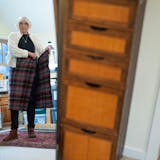Tsundoku. I read the Japanese word and its definition — "the condition of acquiring reading materials but letting them pile up in one's home" — and instantly saw myself and the countless piles of books all over my apartment.
Uh-oh, I thought. I definitely have this. In my case, it also applies to my vintage dresses, heels, lipsticks, perfumes, antique paintings of cows.
I've been what I like to call a "collector" my whole life. My parents are hard-core antiquers. I was groomed from a young age to fill my life with lots and lots of old stuff. Basically, I'm the anti-Marie Kondo. (You know, the woman who wrote about throwing away all of your stuff?) All of my possessions spark joy in me — whether it's the moth-eaten cashmere sweater I bought in Dinkytown in 2007 or a book from Magers & Quinn, a store I love so much I call it "my boyfriend."
If eschewing possessions is your thing, great. It's definitely not mine.
We live in a society that constantly tempts us, baiting us to buy more, more, more. You can't open Instagram without seeing your favorite blogger don a new dress or gorgeous pair of shoes. Tons of modern brands even have their own apps so a shopper can make her purchases while waiting for, say, a cup of coffee. When you're someone like me who loves pretty things, it's hard to know when to stop.
Plus, I make my living as a style and beauty writer. It would be difficult to completely avoid my frequent shopping trips. Technically, it's part of my job.
But then, recently, I realized I was shopping pretty much every day. And it freaked me out. While I mostly shop vintage and resale and rarely buy fast-fashion, I knew I was spending too much. So I challenged myself to curb my habits and examine the reasons for my incessant shopping. Oh, and maybe save a little money in the process.
A "No Buy" month/year/week isn't a new concept; in fact, it's kind of trendy right now. People have written countless online articles and books about what they "learned" while doing a challenge. One person even wrote a manual about it.


